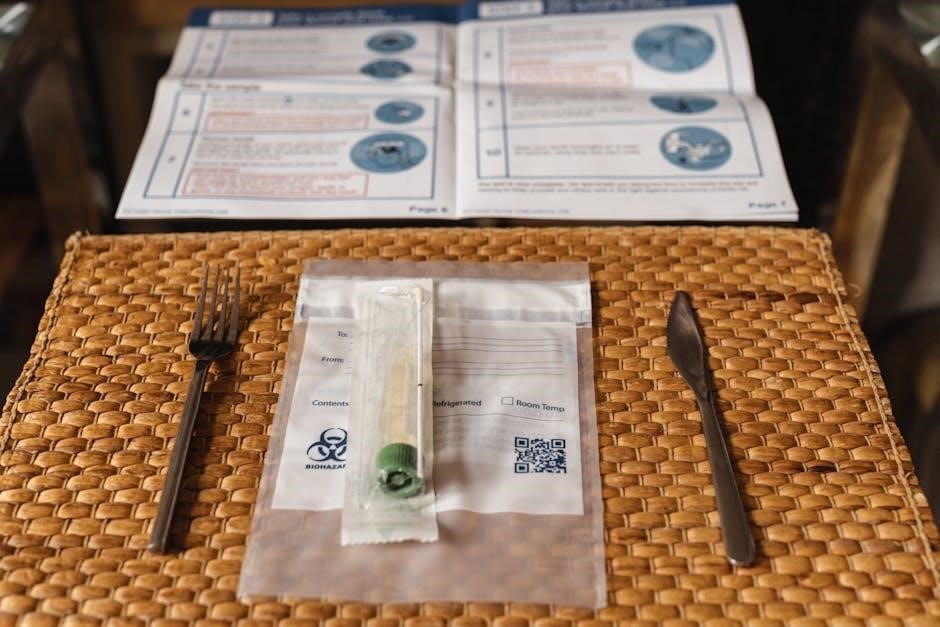1.1 What is GaviLyte-C?
GaviLyte-C is a bowel preparation solution used to cleanse the colon for colonoscopy. It works as an osmotic laxative, helping clear the colon for better visibility.
GaviLyte-C is a bowel preparation solution used to cleanse the colon for colonoscopy. It contains an osmotic laxative that draws fluids into the bowel, loosening stool for easy passage. The solution helps ensure a clear colon, improving visibility during the procedure. GaviLyte-C is commonly prescribed to prepare patients for colonoscopy, ensuring effective bowel cleansing. It is essential to follow the instructions carefully to achieve optimal results. The solution is typically mixed with water and consumed as directed, with specific timing to ensure the colon is clear before the procedure. Proper preparation is critical for accurate exam outcomes.
1.2 Purpose of GaviLyte-C in Colonoscopy Preparation
The primary purpose of GaviLyte-C is to cleanse the colon thoroughly before a colonoscopy, ensuring clear visibility for accurate detection of abnormalities. By emptying the bowel, it prevents stool from obscuring the view, allowing healthcare providers to identify polyps, tumors, or other issues effectively. Proper use of GaviLyte-C ensures the colon is free of solid matter, making the procedure more efficient and reliable. Adhering to the instructions is crucial for achieving the desired cleansing effect, as incomplete preparation may lead to rescheduling or reduced accuracy during the exam.

GaviLyte-C Instructions Overview
Follow instructions carefully to ensure proper colon cleansing. Split the prep into two doses: one the evening before and the second the morning of the procedure.
2.1 Importance of Following Instructions
Following GaviLyte-C instructions is crucial for effective colon cleansing. Proper preparation ensures clear visibility during colonoscopy, increasing the likelihood of detecting polyps or abnormalities. Deviating from guidelines may result in an incomplete cleanse, requiring procedure rescheduling and additional costs. Adhering to the split-dose regimen, clear liquid diet, and avoiding prohibited fluids (e.g;, red, purple, or orange) is essential. Failure to comply may lead to a poor preparation quality, compromising the exam’s accuracy. Always prioritize the instructions provided by your healthcare provider to achieve optimal results and avoid unnecessary delays or complications.
2.2 General Guidelines for Administration
GaviLyte-C administration begins the evening before the colonoscopy. Mix the solution with 1 gallon of water, optionally adding flavor packets for taste. Refrigerate if desired for better palatability. Start drinking the first half (64 ounces) in the evening, consuming 8 ounces every 15-30 minutes. Continue with clear liquids until bedtime. The second half should be taken the morning of the procedure, finishing at least 3 hours before the exam. Avoid solid foods and prohibited fluids to ensure effectiveness. Follow the prescribed schedule strictly to achieve optimal cleansing and avoid delays or rescheduling.

Preparation Steps
Prepare by mixing GaviLyte-C with 1 gallon of water, adding optional flavor packets. Refrigerate for better taste. Follow the timed drinking schedule as instructed.
3.1 Mixing GaviLyte-C Solution
To prepare GaviLyte-C, fill the provided container with water to the marked fill line. Add the entire contents of the GaviLyte-C powder packet and shake vigorously until the powder dissolves completely. For better taste, you can add a flavor packet before mixing. Once mixed, refrigerate the solution if desired, but ensure it is well-shaken before drinking. Proper mixing is essential for the solution to work effectively. Start preparing the solution early to allow time for chilling, which can improve palatability. Always follow the instructions provided with your kit for accurate preparation.
3.2 Timing of Administration
GaviLyte-C should be taken as directed by your healthcare provider, typically starting the evening before your colonoscopy. Begin drinking the first half of the solution around 4-6 PM, consuming 8 ounces every 15-30 minutes. Finish the first half by bedtime. The second half should be taken the morning of the procedure, starting 3-4 hours before your appointment. Complete the entire solution at least 2 hours before the procedure to ensure proper cleansing. Timing is critical for effective colon preparation and to avoid delays or rescheduling. Always follow the specific schedule provided by your doctor or clinic.
3.3 Storage and Refrigeration
Store GaviLyte-C powder at room temperature, away from extreme heat or moisture. Once mixed with water, refrigerate the solution to chill if desired. Do not freeze. Ensure the solution is well-sealed to prevent contamination. Mixed solution should be consumed within 24 hours for optimal effectiveness. Proper storage and refrigeration help maintain the solution’s efficacy and palatability. Always check the expiration date on the powder before use and store it in a secure location out of reach of children. Refrigeration improves taste but is not required for safety or effectiveness.

Dosage Information
GaviLyte-C dosage involves drinking 8 ounces every 15-30 minutes. The total solution is typically split into two doses: one the evening before and the second the morning of the procedure. Complete the entire solution as directed to ensure proper cleansing.
4.1 Amount of Solution to Drink
The total volume of GaviLyte-C solution to drink is typically 4 liters, divided into two equal parts. The first 2 liters are consumed the evening before the procedure, and the remaining 2 liters are taken the morning of the procedure. Patients should drink 8 ounces every 15-30 minutes until the solution is finished. It’s important to complete the entire dose to ensure proper bowel cleansing. Additional clear liquids, such as water or electrolyte-rich beverages, may be consumed to stay hydrated but should be stopped at least 3 hours before the colonoscopy. Follow the recommended schedule strictly for best results.
4.2 Recommended Drinking Schedule
The recommended drinking schedule for GaviLyte-C involves splitting the dose into two parts. The first half (2 liters) should be consumed the evening before the procedure, starting around 4-6 PM. Drink 8 ounces every 15-30 minutes until the first half is finished. The second half (2 liters) should be taken the morning of the procedure, starting 3-4 hours before the colonoscopy. Again, drink 8 ounces every 15-30 minutes. Complete the solution at least 3 hours before the procedure to ensure proper cleansing. Adhering to this schedule is crucial for effective bowel preparation and a successful exam.
4.3 Completion of the Solution
It is essential to finish the entire GaviLyte-C solution as directed. The first half (2 liters) should be completed by bedtime, while the second half (2 liters) must be finished at least 3 hours before the procedure. After finishing the solution, do not drink anything else, including water, until after your colonoscopy. Completing the solution ensures your colon is properly cleansed, allowing for accurate results during the exam. If you cannot finish the solution, contact your healthcare provider immediately, as incomplete preparation may require rescheduling the procedure.

Dietary Guidelines
- Follow a clear liquid diet the day before the procedure.
- Avoid solid foods, red, purple, or orange liquids, gum, and alcohol.
- Allowed fluids include water, clear broths, and electrolyte-containing drinks like Gatorade.
5.1 Clear Liquid Diet Requirements
Start a clear liquid diet the day before your colonoscopy; This includes water, clear broths, electrolyte-containing fluids like Gatorade, and fluids without pulp or solids. Avoid red, purple, or orange liquids, as they may interfere with the procedure. Do not consume solid foods, chewing gum, or alcohol. Clear liquids help ensure your colon is free of residue, allowing for a thorough examination. Stick to fluids that are transparent, such as apple juice without pulp or clear teas. This diet typically begins in the morning or evening before your procedure, depending on the schedule provided by your healthcare provider.
5.2 Foods and Liquids to Avoid
During the colonoscopy preparation, avoid solid foods, alcohol, and red, purple, or orange liquids, as they may interfere with the procedure. Do not consume chewing gum or anything with pulp. Avoid opaque or thick fluids, as they can leave residue in the colon. Refrain from eating solid foods the day before and the day of the procedure. Clear liquids are permitted, but avoid any colored fluids that could mimic blood or obscure visibility during the exam. Adhering to these restrictions ensures a clean colon for accurate results. Consult your healthcare provider if you have questions about specific foods or liquids.
5.3 Allowed Fluids During Prep
Clear liquids are permitted during the preparation phase, such as water, clear broths, electrolyte solutions like Pedialyte, and flavored clear liquids without pulp or sediment. Avoid colored fluids, especially red, purple, or orange, as they may interfere with the procedure. Clear juices, such as apple or grape juice (without pulp), are acceptable. Avoid alcohol, milk, and opaque drinks. Stay hydrated with approved fluids to maintain electrolyte balance and ensure a clear colon for the exam. Always check with your healthcare provider for specific fluid recommendations to avoid any complications during the colonoscopy preparation.

Administration Tips
Drink slowly, 8 ounces every 15-30 minutes, to minimize discomfort. Add flavor packets for better taste. Stay hydrated with clear fluids to aid cleansing and comfort.
6.1 Adding Flavor Packets
Flavor packets can be added to GaviLyte-C to improve taste. Use yellow or green packets to mask bitterness. Add them before mixing the solution for best results. These packets are optional but recommended for better palatability. Follow package instructions for proper use. Adding flavor can make the prep more tolerable, aiding in completing the full dose. Ensure the packet is fully dissolved for consistent taste. This step helps patients adhere to the regimen without discomfort. Adjust flavor to personal preference for a smoother experience. Proper mixing ensures even distribution of electrolytes and active ingredients, maintaining the solution’s effectiveness. Flavor packets are designed to enhance compliance without compromising efficacy.
6.2 Drinking Pace and Comfort
Drinking GaviLyte-C at a steady pace is essential for comfort and effectiveness. Start with 8 ounces every 15-20 minutes to avoid nausea. Sip slowly and avoid gulping to reduce discomfort; If the taste is unpleasant, use a straw to bypass the tongue. Staying hydrated with clear liquids before and after prep helps ease the process. A consistent pace ensures the solution works effectively without causing stomach distress. Proper pacing also helps prevent overwhelming bowel movements. Adjust the speed slightly if needed, but complete the recommended dose within the suggested timeframe to ensure a clean colon for the procedure.
6.3 Handling the Taste
To make GaviLyte-C more tolerable, consider adding flavor packets provided or using lemon slices. Sip through a straw to bypass taste buds. Chill the solution in the fridge beforehand, but avoid freezing. Eat a small snack like crackers beforehand to reduce bitterness. Drinking slowly and steadily helps minimize discomfort. If the taste is overwhelming, rinse your mouth with water after each sip. Ensure the solution is well-mixed to avoid clumps. Stay hydrated with clear fluids to help flush the solution through your system. Remember, the unpleasant taste is temporary but crucial for a successful procedure.

Common Questions
Patients often ask about side effects, dietary restrictions, and incomplete solution consumption. Addressing these ensures clarity and proper preparation for a successful colonoscopy procedure;
7.1 What If I Experience Side Effects?
Common side effects of GaviLyte-C include nausea, bloating, or stomach discomfort. These are usually mild and temporary. If symptoms worsen or persist, contact your healthcare provider. Ensure to complete the prep unless advised otherwise, as it is crucial for a clear colonoscopy result. If severe reactions occur, seek medical attention immediately. Most side effects subside after finishing the solution, and the benefits of a successful procedure outweigh temporary discomfort. Always follow your doctor’s guidance for managing any adverse effects during the preparation process.
7.2 Can I Eat Solid Foods During Prep?
No, solid foods should not be consumed during GaviLyte-C preparation. Stick to a clear liquid diet to ensure the colon remains clear for the procedure. Avoid red, purple, or orange liquids, as they may interfere with visibility. Clear liquids like water, broth, or electrolyte-rich beverages are recommended. Solid foods can leave residue, potentially requiring the procedure to be rescheduled. Follow the dietary guidelines provided to ensure optimal preparation and avoid complications. Always consult your healthcare provider if unsure about allowable foods or liquids during the prep period.
7.3 What If I Can’t Finish the Solution?
If you cannot finish the GaviLyte-C solution, contact your healthcare provider immediately. Incomplete preparation may result in a poor colonoscopy outcome. Stool remaining in the colon can hide abnormalities, potentially requiring the procedure to be rescheduled. If you struggle to finish, try drinking slowly or using flavor packets to mask the taste; Avoid consuming solid foods or non-clear liquids, as they may interfere with the prep. Completing the solution is crucial for a successful exam, so seek guidance if you encounter difficulties. Do not delay in reaching out to your provider for further instructions.

Special Considerations
Special considerations for GaviLyte-C include pediatric use, medication adjustments, and emergency contact information to ensure safe and effective preparation for colonoscopy.
8.1 Pediatric Use
GaviLyte-C is approved for pediatric patients aged 6 months and older. Dosage adjustments may be necessary based on age and weight. Children should be closely monitored for dehydration and electrolyte imbalances. Parents or guardians should ensure the child follows the prescribed regimen and reports any adverse reactions. The solution should not be administered to infants under 6 months unless directed by a healthcare provider. Always consult a pediatrician for specific guidance tailored to the child’s needs to ensure safe and effective preparation.
8.2 Medication Adjustments
Medication adjustments may be necessary before using GaviLyte-C. Consult your healthcare provider, especially if taking diuretics, NSAIDs, or medications affecting electrolytes. Certain medications should be paused 24-48 hours prior to preparation to avoid interactions. Blood pressure medications and electrolyte-affecting drugs may need dosage changes. Ensure your provider is aware of all medications, including supplements, to prevent complications. Adjustments are crucial to maintain hydration and electrolyte balance during prep. Follow specific guidance for your medical history to ensure safety and effectiveness of the colonoscopy preparation.
8.3 Emergency Contact Information
In case of severe side effects or concerns, contact your healthcare provider immediately. For emergencies, dial 911 or visit the nearest emergency room. If you experience chest pain, difficulty breathing, or severe abdominal pain, seek urgent medical attention. For non-emergency questions, contact the GI Nurse at (650) 299-2256 or (650) 299-2718. Keep these numbers handy during preparation. If unsure about symptoms or reactions, do not hesitate to reach out to your healthcare team or emergency services. Prompt action ensures your safety and the success of your colonoscopy preparation.

Day Before the Procedure
Start a clear liquid diet and mix the GaviLyte-C solution in the evening. Begin drinking the first half (64 ounces) every 15-30 minutes, continuing with clear liquids until bedtime.
9.1 Evening Routine
Begin by mixing the GaviLyte-C solution as instructed, typically in the evening. Start drinking the first half (64 ounces) at a pace of 8 ounces every 15-30 minutes. Continue drinking clear liquids until bedtime to stay hydrated. Avoid solid foods and red, purple, or orange liquids. Complete the first half of the solution by the evening to ensure proper preparation. This routine helps cleanse the colon effectively for the procedure. Stick to the schedule to achieve the best results and avoid delays. Proper preparation is key for a successful colonoscopy. Follow the timing and guidelines carefully for optimal outcomes.
9.2 Overnight Preparations
After completing the evening dose, refrigerate the remaining GaviLyte-C solution for the next morning. Ensure you finish the first half of the solution by bedtime to allow it to work overnight. Avoid eating solid foods and stick to clear liquids if needed. Stay hydrated with water or approved fluids. Rest well to prepare for the final dose in the morning. Complete the second half of the solution as instructed, ensuring it’s finished at least 3 hours before the procedure. Proper overnight preparation ensures your colon is clear for a successful exam. Follow the schedule strictly for the best results.

Day of the Procedure
Finish the remaining GaviLyte-C solution by the specified time, usually 3-4 hours before the procedure. Only clear liquids are allowed until the procedure begins.
10.1 Final Dosage Timing
Finish the remaining GaviLyte-C solution 3-4 hours before your procedure to ensure proper bowel cleansing. Complete the entire dose as instructed to avoid residue. After finishing, only clear liquids are permitted until the procedure. Avoid solid foods and red or purple liquids, as they may interfere with visibility. Sticking to this timeline ensures your colon is clear for an accurate exam. If instructions aren’t followed, your procedure might be rescheduled. Stay hydrated with allowed fluids to maintain comfort and readiness for your colonoscopy.
10.2 Last-Minute Instructions
Arrive at least 30 minutes before your scheduled time. Wear loose, comfortable clothing and avoid jewelry. Bring your ID, insurance cards, and a list of medications. Ensure someone escorts you home, as you cannot drive until the next day. Only clear liquids are permitted until 3 hours before the procedure. Avoid eating or drinking anything solid. Use the restroom before leaving home, as bathroom access may be limited during prep. Stay calm, follow all instructions, and remember that your care team is available for last-minute questions. Proper preparation ensures a safe and effective colonoscopy experience.
Adherence to GaviLyte-C instructions ensures effective colon cleansing, promoting a successful colonoscopy. Proper preparation is key to clear results and patient safety.
11.1 Final Reminders
Ensure you complete the entire GaviLyte-C solution as directed to achieve optimal colon cleansing. Stay hydrated with clear fluids and avoid solid foods after the final dose; Refrain from consuming red, purple, or orange liquids to prevent interfering with exam results. Finish the solution at least 3 hours before your procedure to allow proper bowel clearance. Arrive on time and inform your healthcare provider of any medications or concerns. Following these steps ensures a safe and effective colonoscopy, improving the accuracy of your results and overall experience.
11.2 Importance of Compliance
Compliance with GaviLyte-C instructions is crucial for a successful colonoscopy. Proper preparation ensures clear visibility of the colon, allowing accurate detection of polyps or abnormalities. Inadequate cleansing may require rescheduling, leading to additional costs and inconvenience. Stool remaining in the colon can obscure results, potentially delaying diagnosis or treatment. Strictly follow the prescribed dosage, timing, and dietary guidelines to achieve optimal bowel preparation. Completing the solution as directed ensures your safety and the effectiveness of the procedure. Non-compliance may result in complications or the need for repeat preparation, emphasizing the importance of adhering to the instructions provided by your healthcare provider.



































